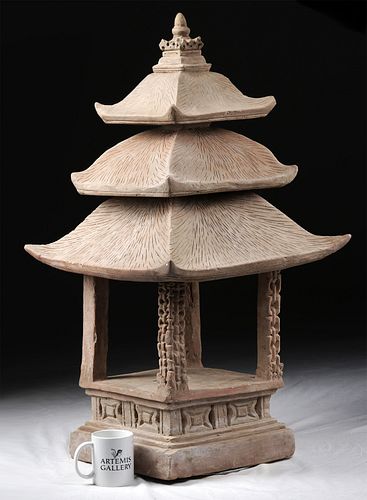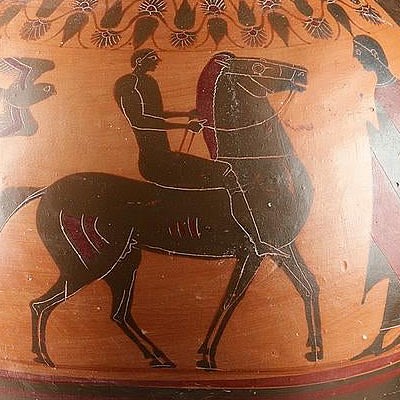Massive 12th C. Majapahit Pottery Stague of a Pagoda
Lot 115
About Seller
Artemis Gallery
686 S Taylor Ave, Ste 106
Louisville, CO 80027
United States
Selling antiquities, ancient and ethnographic art online since 1993, Artemis Gallery specializes in Classical Antiquities (Egyptian, Greek, Roman, Near Eastern), Asian, Pre-Columbian, African / Tribal / Oceanographic art. Our extensive inventory includes pottery, stone, metal, wood, glass and textil...Read more
Categories
Estimate:
$8,000 - $12,000
Absentee vs Live bid
Two ways to bid:
- Leave a max absentee bid and the platform will bid on your behalf up to your maximum bid during the live auction.
- Bid live during the auction and your bids will be submitted real-time to the auctioneer.
Bid Increments
| Price | Bid Increment |
|---|---|
| $0 | $25 |
| $300 | $50 |
| $1,000 | $100 |
| $2,000 | $250 |
| $5,000 | $500 |
| $10,000 | $1,000 |
| $20,000 | $2,500 |
| $50,000 | $5,000 |
| $100,000 | $10,000 |
| $200,000 | $20,000 |
About Auction
By Artemis Gallery
Jun 4, 2020
Set Reminder
2020-06-04 10:00:00
2020-06-04 10:00:00
America/New_York
Bidsquare
Bidsquare : Exceptional Antiquities, Asian, Ethnographic
https://www.bidsquare.com/auctions/artemis-gallery/exceptional-antiquities-asian-ethnographic-5185
An important one-day auction featuring museum-worthy examples of Egyptian, Greek, Roman, Etruscan, Near Eastern, Far East / Asian, Pre-Columbian, African / Tribal, Oceanic, Native American, Spanish Colonial, Russian, Fossils, Ancient Jewelry, Fine Art, so much more! Artemis Gallery info@artemisgallery.com
An important one-day auction featuring museum-worthy examples of Egyptian, Greek, Roman, Etruscan, Near Eastern, Far East / Asian, Pre-Columbian, African / Tribal, Oceanic, Native American, Spanish Colonial, Russian, Fossils, Ancient Jewelry, Fine Art, so much more! Artemis Gallery info@artemisgallery.com
- Lot Description
Southeast Asia, Indonesia, Java, Majapahit Empire, ca. 12th century CE. A massive statue of a pagoda, composed of four pieces of interlocking fired pottery: a tiered platform with four arms, and three slanting, pyramidal roofs of successive size, with the smallest topped by a tiered spire. The pagoda, a tiered tower whose form originates with the stupa, a Buddhist religious monument that symbolizes the Buddha's presence, was a feature of monumental architecture in the Majapahit world. During the later Majapahit Empire, the buildings of East Java - both religious and secular - were decorated with friezes made from stone and terracotta. A votive stupa like this would have had its place in a building like that. The brick so artfully depicted on the base of this sculpture is a delightful reminder of the brick architecture of the Majapahit capital, Trowulan, which remain today. Thin layers of brick allowed Majapahit artists to create dramatic visual effects with their buildings, as at Candi Brahu. An incredibly rare depiction from a little-known culture! Size: 18.5" L x 18.5" W x 38.5" H (47 cm x 47 cm x 97.8 cm)
Provenance: private Hawaii, USA collection, acquired in 1998; ex-private De Maria collection, Italy
All items legal to buy/sell under U.S. Statute covering cultural patrimony Code 2600, CHAPTER 14, and are guaranteed to be as described or your money back.
A Certificate of Authenticity will accompany all winning bids.
We ship worldwide and handle all shipping in-house for your convenience.
#146132This is composed of four interlocking pieces. All four pieces have been repaired and restored with some new clay and the total piece is approximately 75% original. Some small losses from peripheries - corners, edges, etc., commensurate with age. Light deposits on surface with some small collection labels in dark ink.Condition
- Shipping Info
-
All shipping is handled in-house for your convenience. Your invoice from Artemis Gallery will include shipping calculation instructions. If in doubt, please inquire BEFORE bidding for estimated shipping costs for individual items.
-
- Buyer's Premium



 EUR
EUR CAD
CAD AUD
AUD GBP
GBP MXN
MXN HKD
HKD CNY
CNY MYR
MYR SEK
SEK SGD
SGD CHF
CHF THB
THB















